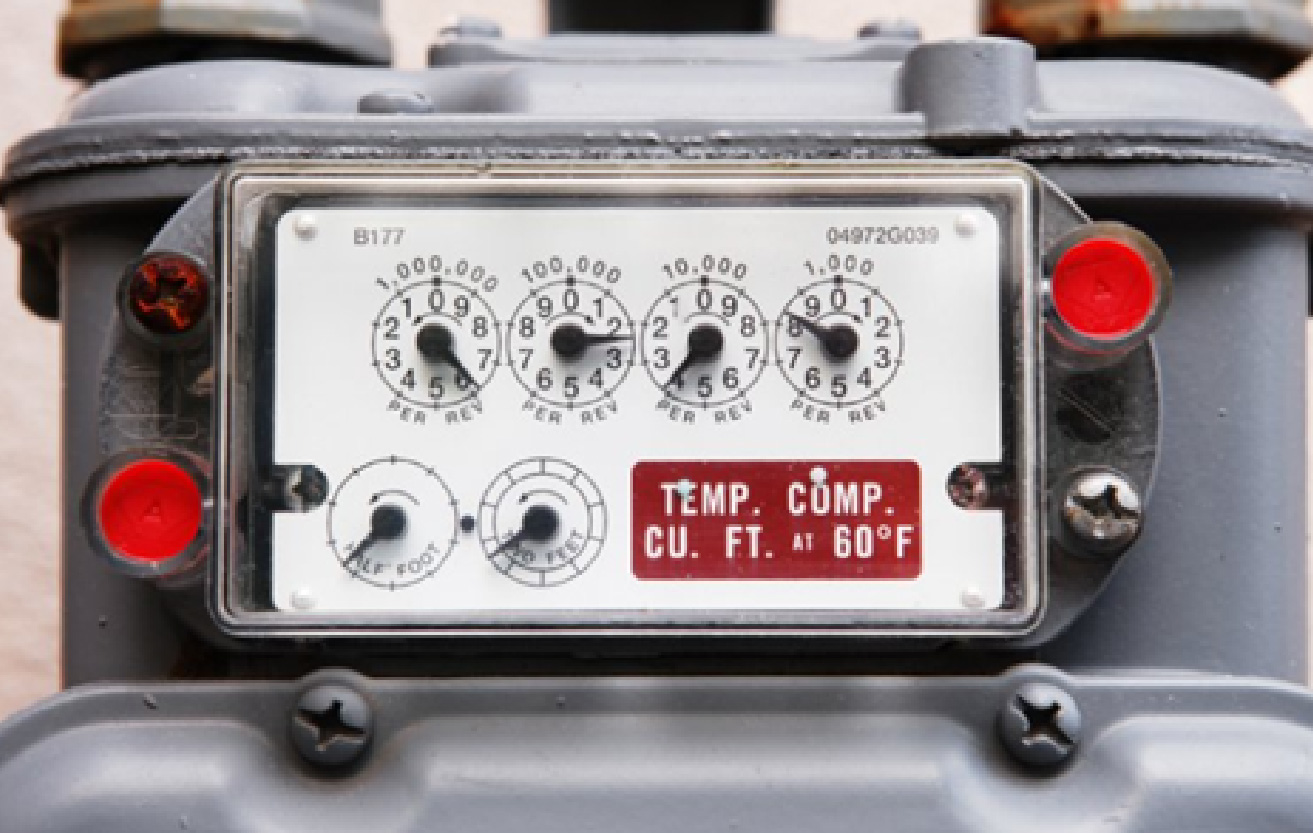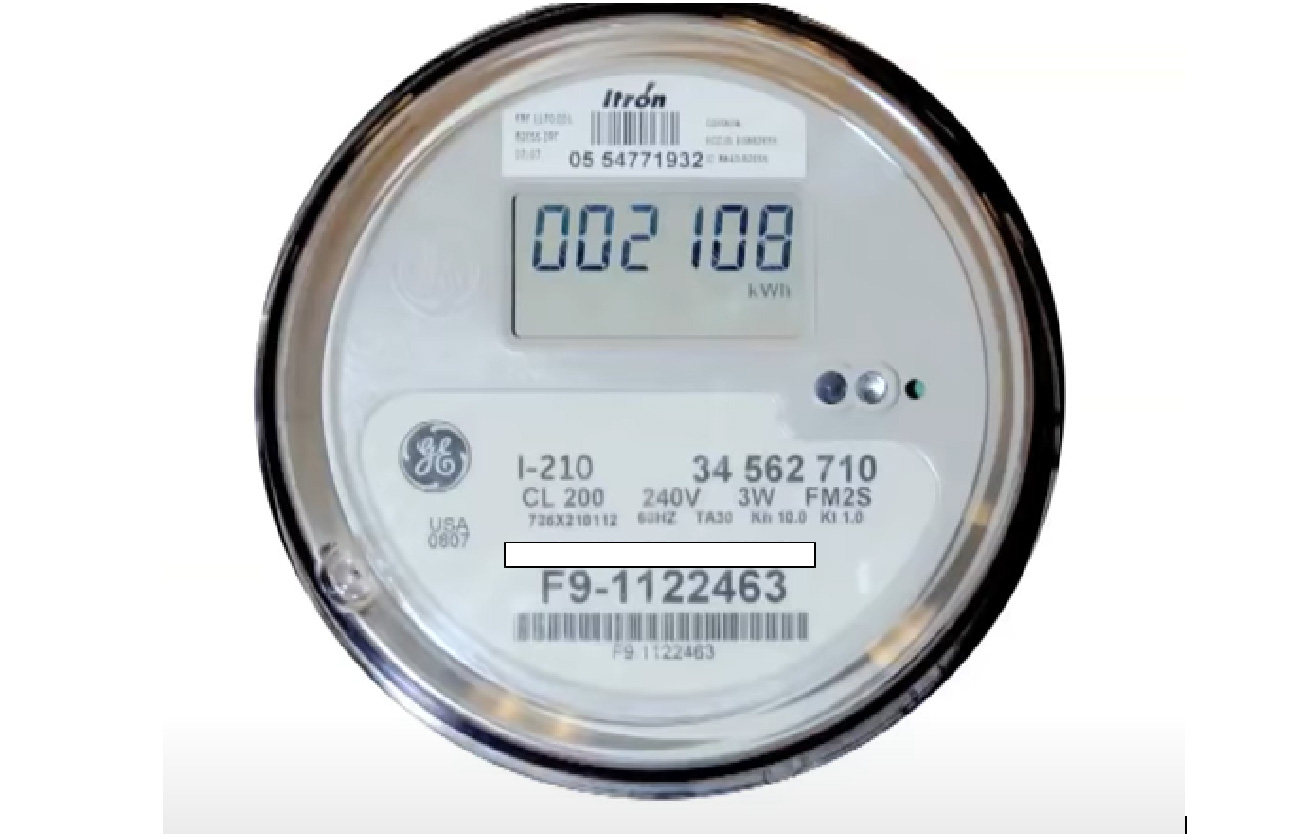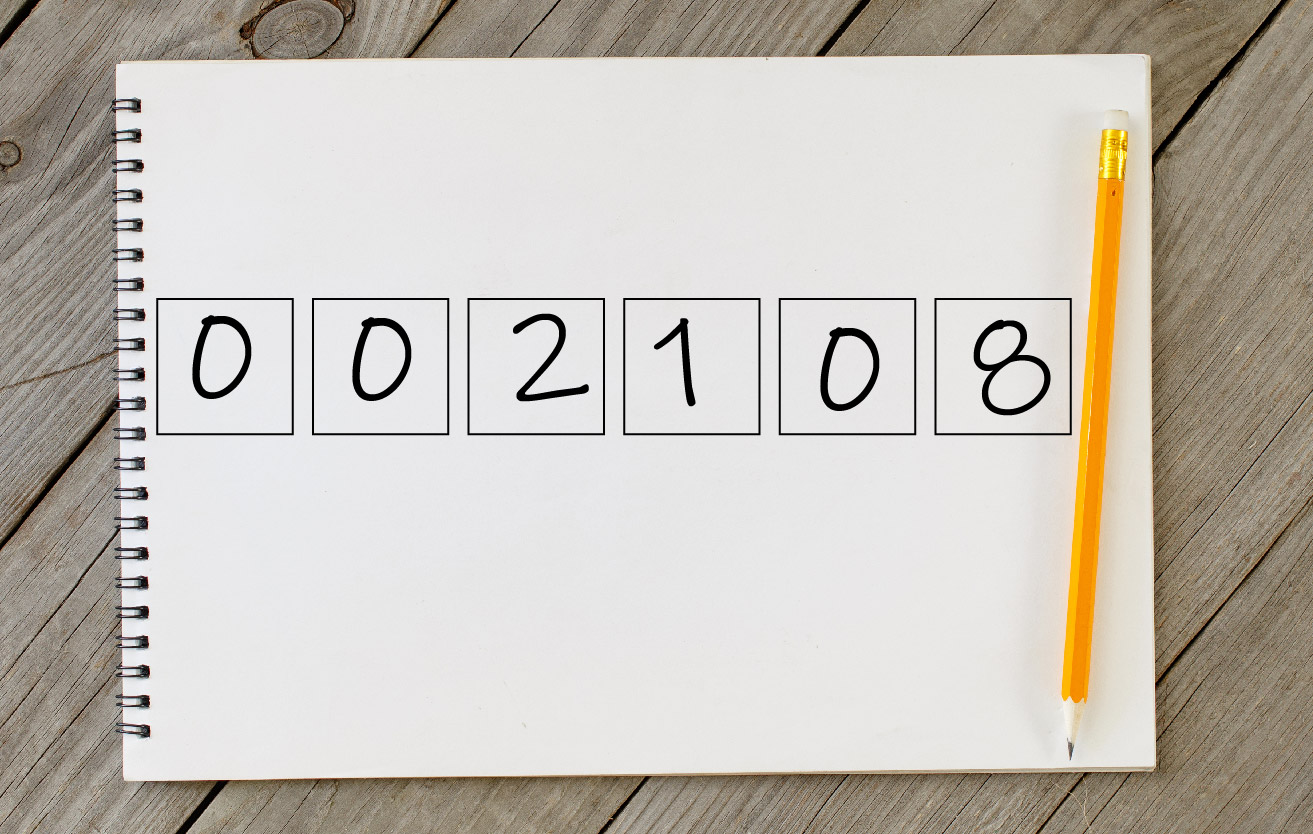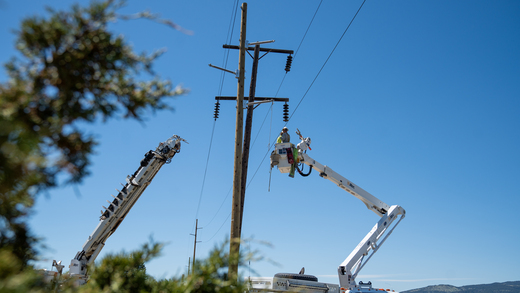Non-communicating meters
How do I read my non-communicating meter?
Click the links below for instructions on how to read your meter, self-read dates and a postcard you can use to submit your meter readings.
Gas meter

Gas meter
Natural gas dials represent the amount of natural gas measured in volumes of hundreds of cubic feet (ccf).
A gas meter is driven by the force of the moving gas in the pipe, and also turns faster as the flow increases. Each time the dial with the lower value makes one complete revolution, the pointer on the next higher value dial moves ahead one digit.
To read your meter:
- Be at eye level of the dials.
- Mark the dials from left to right.
- Take note of the direction of the arrows on the display – the pointer of adjacent dials turn in opposite directions to each other.
- Draw the pointer on the dials as displayed on your gas meter.
- When the pointer on the dial is between two numbers, record the lower number.
- If the pointer is between 9 and 0, 9 is the lower number.
- When the pointer is directly on the number, look at the dial to its right:
- Has the dial on the right has passed 0, yes, use the number that the pointer is on.
- The dial on the right has not passed "0," use the number less than what the pointer is on.
Example:
In the example below, the reading is: 6 2 3 8


Electric meter

Electric meter
The basic unit of measure of electric power is the watt. One thousand watts is called a kilowatt.
When you use one thousand watts of power in one hour, you have used one kilowatt (kWh).
We bill you by the kWh. Your electric meter is a digital meter that has an electronic display that displays the current reading, like a digital clock.
When reading an electric meter, write down the numbers as shown on the meter.
Example:
In the example below, the reading is: 0 0 2 1 0 8


When submitting your meter reads, please be ready with your account number, your service address, your meter read(s) and the date you read your meter(s).
Options to submit your meter reads:
- Submit online in My Energy Account
- Call (888) 467-2669; M-F 7 a.m.-6 p.m.
- Mail the meter reading card to us at:
Communicating meters
How do I read my communicating advanced meter?
Click the links below for instructions on how to read your meter, self-read dates and a postcard you can use to submit your meter readings.
Advanced Meter FAQs
What is the advanced meter project timeline in Montana?
NorthWestern Energy began installation in Montana in 2021. Here is a list of approximate dates for the Montana Meter Upgrade project by area:
- Missoula Division: completed August 2022
- Butte Division: completed June 2022
- Bozeman Division: completed May 2024
- Billings Division: completed October 2024
- Lewistown District: completed October 2024
- Havre District: completed November 2024
- Helena Division: June 2024 – May 2025
- Great Falls Division: August 2024 – May 2025
Will I have to pay for the meter?
Who will change my meter?
NorthWestern Energy contracted with Tru-Check to install the new digital meters, the same company that installed the first generation, one-way communication digital meters in 1998 that are in use today.
Tru-Check technicians will wear apparel with the Tru-Check logo and will carry a NorthWestern Energy contractor identification badge.
When will the meters be installed and do I need to be home?
Most of the installations will occur Monday through Friday during business hours, though there will be cases when evening or weekend installations may be necessary. Customers don't need to be home.
A door hanger will let residents know their upgrade was successful. If the technician cannot perform the upgrade, a door hanger will be left with instructions to call to make an appointment.
If you are both an electric and natural gas NorthWestern Energy customer, the new electric meter will be installed first and the new gas module will be installed during a follow-up visit to your home or business in about eight weeks.
What happens to the meter on my home or business now?
Are radio frequency (RF) emissions coming from the meters and modules?
Yes. The Federal Communications Commission (FCC) regulates the safety limits for all RF emissions, and smart meter and module emissions make up a small portion of the limit. The RF emissions of the one-way communication meters in use now and the two-way communication meters that are being installed for this technology upgrade are both approved by the FCC. Radio frequency emissions are also produced by common household devices such as microwaves, baby monitors and TVs.
Is customer information protected?
Yes. Customer privacy and security are NorthWestern Energy priorities. The company’s strict security standards have contributed to protecting the energy grid and customer privacy for years. The meters do not collect, store or transmit any personally identifiable information.
The meters measure total energy and cannot differentiate energy usage by appliance or anything else within a home or business. The transmitted energy use information is encrypted.What if I don’t want an upgraded meter?
Customers who want to keep their existing meters can call NorthWestern at 888-467-2669 or email NorthWesternEnergyMeters@northwestern.com to be added to the bypass list. Customers who previously requested an opt out do not need to contact NorthWestern again to be bypassed and keep their meters.
NorthWestern will be reaching out to customers who received an advanced meter despite their request to opt out. For those who still wish to opt-out, NorthWestern will ensure that the advanced meter is removed and replaced with a meter similar to the one that was there before. Customers will not be charged for this service.
Customers who have questions about the advanced meter opt-out program can contact NorthWestern at 888-467-2669
or the Montana Public Service Commission at 1-800-646-6150 or pschelp@mt.gov.

NorthWestern Energy announces settlement agreements in Montana electric and natural gas regulatory rate review
Date: Apr 15, 2025
TYPE: News
Category: Investors
Sioux Falls, S.D./Butte, Mont. – April 15, 2025 – NorthWestern Energy Group, Inc. d/b/a NorthWestern Energy (Nasdaq: NWE) reached settlement agreements in its Montana electric and natural gas regulatory rate review with the Montana Consumer Counsel, which represents consumers in hearings before the Montana Public Service Commission, the Montana Large Customer Group, which includes Ash Grove Cement Company, Calumet Montana Refining, Enbridge (U.S.) Inc., GCC, Par Montana, Phillips 66, REC Silicon Inc., and Stillwater Mining Company, the Federal Executive Agencies, which includes Malmstrom Air Force Base and other federal agencies with offices in NorthWestern Energy’s Montana service area, and Walmart Inc., which has 16 retail stores and 4,900 employees in Montana.
Customer Bill Impact
Natural Gas Settlement: If approved by the Montana Public Service Commission, a typical natural gas residential customer using 65 therms per month would see a monthly bill increase of $4.74, or 9.14% from rates on July 1, 2024.
Partial Electric Settlement: If the electric settlement and NorthWestern’s proposals for the new generation resource, the Yellowstone County Generating Station, state property taxes and supply costs are approved, a typical electric residential customer would see a monthly bill increase of $4.63, or 4.21% from rates on July 1, 2024.
Statement from NorthWestern Energy
“Our customers deserve the most reliable energy service available,” said NorthWestern Energy President and Chief Executive Officer Brian Bird. “Our employees work every day to deliver this service safely, 24 hours a day, 365 days a year, while keeping bills as low as possible. The cost of delivering safe, reliable energy includes maintaining a vast natural gas and electric infrastructure network.
We are pleased that the parties in these constructive settlements prioritized the best interests of our customers. These agreements ensure that NorthWestern Energy can continue making the necessary energy system investments for safe and reliable energy service for our communities.”
Financial Impact
If approved, the settlement agreements are expected to increase annual natural gas base revenues by approximately $18 million and increase annual electric base revenues, excluding Yellowstone County Generating Station, by approximately $66.4 million.
Including the unsettled request for the Yellowstone County Generating Station, NorthWestern’s base revenue request is $110.3 million. When considering NorthWestern’s proposed reduction to the flow-through Power Cost and Credit Adjustment Mechanism ($94.5 million) and its property tax tracker ($1.2 million), customer electric bills will be impacted by the net $14.6 million increase in revenues.
The natural gas settlement is based on an authorized return on equity of 9.60% for natural gas operations, and a 47.8% equity component of the capital structure.
The partial electric settlement is based on an authorized return on equity of 9.65% for electric operations, which is consistent with the current authorized ROE, and a 47.8% equity component of the capital structure.
Additional Settlement Terms
- Standby Tariff: NorthWestern Energy and the University of Montana reached a settlement agreement for the proposed Standby Tariff. If approved by the Montana PSC, the settlement standby rates will be effective for customers that rely on NorthWestern Energy for backup power, but provide their own energy service most of the time.
- Colstrip Plant Transition: NorthWestern Energy and the Northern Cheyenne Tribe reached a settlement agreement that defines the Tribe’s involvement in transition planning for the Colstrip Plant, which is east of the Northern Cheyenne Reservation. The Northern Cheyenne Tribe recognizes NorthWestern Energy’s impending majority ownership of the Colstrip Plant as a commitment to responsible stewardship, long-term energy reliability and economic sustainability for the region.
The settlement agreements were submitted to the Montana Public Service Commission for its consideration.
Yellowstone County Generating Station and Supply Costs
NorthWestern Energy’s proposals for the Yellowstone County Generating Station and for recovery of flow-through supply costs are not included in the settlement agreements.
"This facility has already contributed to a significant decrease in rates for our Montana residential customers, with rates dropping by more than 5% starting Dec. 1, 2024, partly due to the Yellowstone County Generating Station's service to our customers," said Bird. "The annual rate benefit for our Montana customers from the plant is expected to be $4.1 million, based upon our request."
The Yellowstone County Generating Station and Power Cost and Credit Adjustment Mechanism proposals, along with other non-revenue matters, will be litigated during the Montana Public Service Commission public hearing beginning April 22, 2025.
Follow us on Facebook and LinkedIn and Instagram: @NorthWesternEnergy
NorthWestern Energy - Delivering a Bright Future
NorthWestern Energy Group, Inc., doing business as NorthWestern Energy, provides essential energy infrastructure and valuable services that enrich lives and empower communities while serving as long-term partners to our customers and communities. We work to deliver safe, reliable, and innovative energy solutions that create value for customers, communities, employees, and investors. We do this by providing low-cost and reliable service performed by highly-adaptable and skilled employees. We provide electricity and / or natural gas to approximately 775,300 customers in Montana, South Dakota, Nebraska, and Yellowstone National Park. Our operations in Montana and Yellowstone National Park are conducted through our subsidiary, NW Corp, and our operations in South Dakota and Nebraska are conducted through our subsidiary, NWE Public Service. We have provided service in South Dakota and Nebraska since 1923 and in Montana since 2002.
Investor Relations Contact: Media Contact:
Travis Meyer (605) 978-2967 Jo Dee Black (866) 622-8081 travis.meyer@northwestern.com jodee.black@northwestern.com


